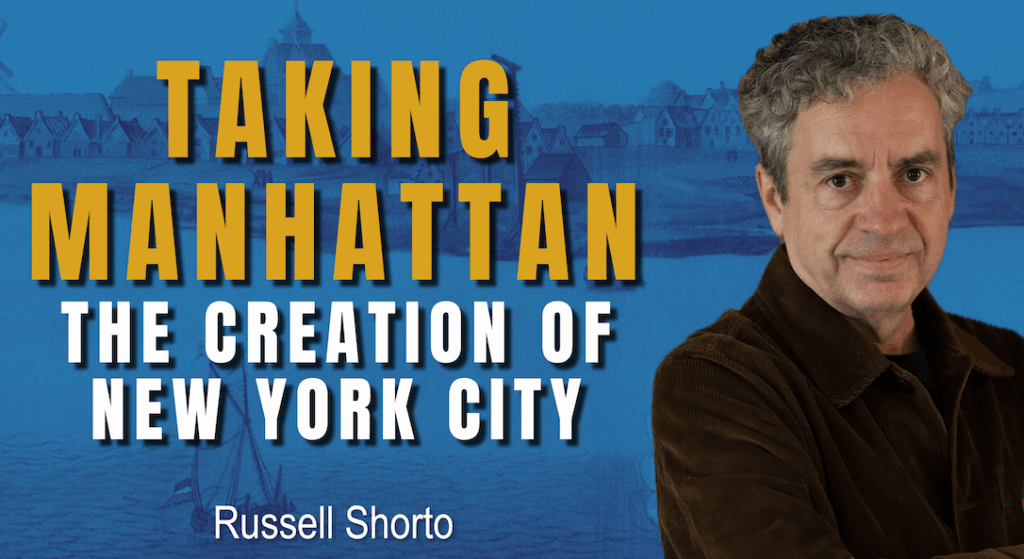Taking Manhattan: The Birth of New York City
October 8, 2025

Listen and subscribe to the podcast
Join The American Idea’s Listener Email list – get news about upcoming episodes and a chance to offer questions for them, too!
Long before New York became the world’s financial capital, a small Dutch trading post at the southern tip of Manhattan Island was pioneering a radical experiment in religious tolerance, multiculturalism, and free enterprise. The story of New Amsterdam, and its peaceful transformation into New York in 1664, reveals how a brief 40-year period of Dutch rule established the cultural and economic foundations that would make the city, and ultimately America itself, a global powerhouse.
This week Jeff discusses New York’s fascinating and largely under-appreciated origins with author Russell Shorto.
A Revolutionary Approach to Colonial Settlement
When the Dutch West India Company established New Netherland in 1624, following Henry Hudson’s 1609 exploration of the region, they brought an approach to colonization that differed markedly from their European rivals. While England, France, and Spain enforced religious uniformity and centralized control in their colonies, the Netherlands applied the same policy of religious tolerance that had made Amsterdam the most dynamic trading city in Europe.
This wasn’t idealism; it was pragmatic business strategy. In 17th-century Europe, where religious intolerance was official policy and considered necessary for social cohesion, the Dutch turned conventional wisdom on its head. By welcoming people of different faiths and ethnicities, they attracted talent, capital, and trading networks that their competitors could not access. Amsterdam became an unusually mixed, multilingual city, and this diversity proved excellent for business, opening doors to markets and ideas across the globe.
The Dutch applied this winning formula to their North American colony. New Amsterdam, founded in 1626 as the capital of New Netherland, quickly became a mirror of its European parent. At one point, 18 languages were reportedly spoken in the small settlement—an astonishing diversity for a colonial outpost. The colony encompassed not just Manhattan but extended across parts of present-day New York, New Jersey, Pennsylvania, Delaware, and Connecticut.
The First Modern City
What made New Amsterdam arguably America’s first modern city was its independence from traditional sources of authority. Unlike the Puritan colonies of New England, which were fundamentally religious projects, or the plantation economies of the South, New Amsterdam was built on capitalism and trade. It answered neither to a monarch nor to a church, but to the forces of commerce and the pragmatic needs of business.
The West India Company initially sought to maintain a trading monopoly, particularly in furs obtained from Native American trappers. But the company soon found it couldn’t make the venture profitable alone and opened the colony to private traders. What followed was a dynamic, entrepreneurial culture where everyone was a merchant with their own networks stretching to the Caribbean, South America, and various European ports. Ship manifests reveal constant experimentation—timber, salt, manufactured goods—as traders sought profitable opportunities in an increasingly globalized economy.
This openness extended, with significant limitations, to relations with indigenous peoples. The Dutch came to trade, not to conquer or convert, and generally maintained commercial relationships with various Native American tribes who valued European manufactured goods like kettles, knives, and muskets. However, this pragmatic coexistence broke down periodically into violence, most notably during Kieft’s War in the 1640s, when Dutch forces massacred two entire Native villages. These episodes reveal the boundaries of Dutch tolerance and the brutal realities of colonial contact.
The colony’s progressive reputation must also be qualified by its participation in slavery. The first enslaved Africans arrived in 1627, just a year after New Amsterdam’s founding. While slavery never became as central to the economy as in Southern colonies—the work didn’t require large-scale enslaved labor—the practice existed throughout the colony’s Dutch period and grew significantly under later leadership.
Peter Stuyvesant’s Transformation
Peter Stuyvesant, who arrived as director of the colony in 1647, proved to be the most effective of the Dutch West India Company’s appointed leaders. For 17 years, until the English takeover in 1664, he developed New Amsterdam into a sophisticated and successful trading port. His administration fostered the merchant culture and business practices that would, after the English transition, make New York synonymous with American finance. It’s no accident that Wall Street—originally the northern boundary of the Dutch settlement—became the center of global capitalism.
Stuyvesant was a complex figure whose legacy includes both commercial success and the expansion of slavery late in the colony’s life. His greatest test would come in the late summer of 1664, when four English ships carrying 450 soldiers and massive stores of weapons and gunpowder sailed into New York harbor.
The Negotiated Transition
The English crown, restored in 1660 after the Puritan Commonwealth and civil war, was determined to build a trading empire rivaling the Dutch. Looking across the Atlantic, King Charles II and his advisors recognized that the Dutch colony occupied prime real estate with extraordinary commercial potential. They appointed Richard Nicolls, a trusted associate from childhood, to lead an expedition to seize it.
But what happened next was unprecedented in colonial history. Rather than immediately attacking New Amsterdam, Nicolls anchored at Gravesend, an English settlement within the Dutch colony, and opened negotiations. Over two weeks of careful diplomatic exchange, both sides engaged in strategic thinking that would reshape North America.
Nicolls recognized that while he had superior military force, simply leveling the settlement would give him only Manhattan Island. If he could win over the population peacefully, he would gain not just territory but a functioning global trading network and a diverse, skilled population that had spent 40 years building commercial relationships across the Atlantic world.
Stuyvesant and the colonists, meanwhile, understood that the Dutch West India Company had failed to adequately support them with soldiers or settlers. The continent stretched before them, ripe for development, and they knew the English had the resources to exploit it. Stuyvesant faced a difficult choice between loyalty to the Dutch government and loyalty to the place and people he had lived among for 17 years.
The resolution came in the form of the Articles of Surrender—though “surrender” is a misnomer. The agreement was essentially a bill of rights guaranteeing colonists their homes, families, property, and crucially, their trade networks. It was, in effect, a merger rather than a conquest, blending Dutch commercial culture onto England’s growing empire.
Nicolls, who became the first English governor of New York (choosing the name himself to honor his patron, the Duke of York), largely honored these terms. When London attempted to impose Navigation Acts restricting which ships could enter English ports, Nicolls sided with his colonists, arguing that Dutch ships should continue to be allowed because free trade was the foundation of the colony’s success.
A Lasting Legacy
The Dutch character persisted in New York long after 1664, not primarily in language or place names, but in fundamental attitudes: religious tolerance, multiculturalism, openness to global trade, and a business-oriented pragmatism. These qualities became inseparable from New York’s identity through colonial America and into the modern era.
The transformation was completed two centuries later when the Erie Canal opened in the 1820s, making the Hudson and Mohawk Rivers—the water route the Dutch had identified in the 1600s—navigable all the way to the Great Lakes. This turned New York into the funnel through which goods and people flowed into the American interior, fulfilling the vision the Dutch had foreseen.
Perhaps most significantly, Nicolls’ dual missions in 1664—taking New Amsterdam and subjugating the Puritan colonies of New England—established two competing ideological power centers that continue to shape American politics. New York became the center of pluralistic capitalism and outward-looking cosmopolitanism. Boston remained the center of Puritanism and what might be called Christian nationalism or an “America first” sensibility. These two forces, one inclusive and commercially oriented, the other morally prescriptive and inward-looking, have battled throughout American history. The nation has typically thrived when these impulses remain in balance, and struggled when one becomes completely ascendant.
In this sense, the peaceful merger of 1664 wasn’t merely the creation of New York—it was a founding moment for competing visions of America itself.
Get Russell Shorto’s book, Taking Manhattan: The Extraordinary Events That Created New York and Shaped America.

